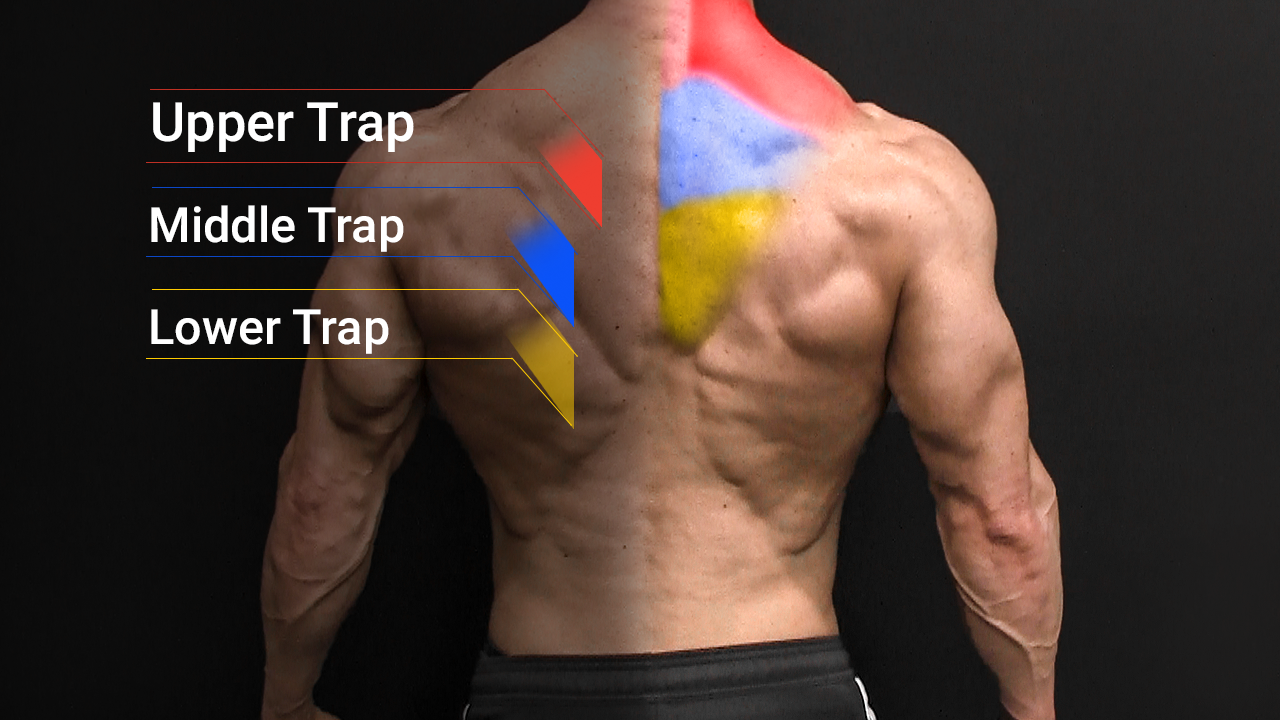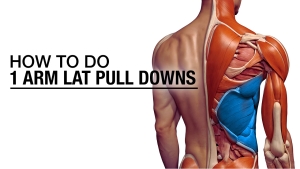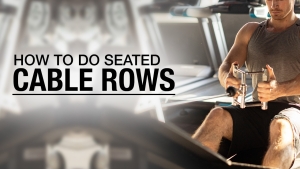
HOW TO HIT THE MIDDLE TRAPS
Even as people become more educated in their fitness routines, certain muscle groups still fly under the radar, overlooked and undertrained.
Topping this list are the trapezius muscles, or ‘traps.’
It’s bad enough that the trap muscles don’t get the attention they deserve. But out of the three sections of the muscle, I’d argue the mid traps are ignored the most.
They’re not as visible as the upper traps and not as directly engaged as the lower traps in most workouts. But their role in stabilizing and strengthening the upper body can’t be overstated.
Let’s take a closer look at the role of the middle traps in our day-to-day movements and complete shoulder muscle development. I’ll also focus on the best exercises for middle traps.
MIDDLE TRAPEZIUS MUSCLE ANATOMY
Before I cover the best exercises for huge traps and stronger traps, I want to make sure you understand where the muscle is and how it functions.
Why is this important for trap training?
If you’re just mindlessly moving through the motions during a set, totally unaware of how the muscle functions, you’re cheating yourself out of results.
What’s more, you could be setting yourself up for strength imbalances.
When you know where this three-part muscle is and how it works, you make it easier for yourself to build a strong mind-to-muscle connection, which I’m a big fan of.
With that said, let’s take a closer look at the trapezius muscle anatomy with a special focus on the mid traps muscle fibers.
The trapezius muscle covers a significant portion of your upper back and neck, and it gets its name from its trapezoid shape.
The muscle fibers are separated into three regions: the upper, middle, and lower trapezius, each serving unique functions for movement.
MID TRAPS

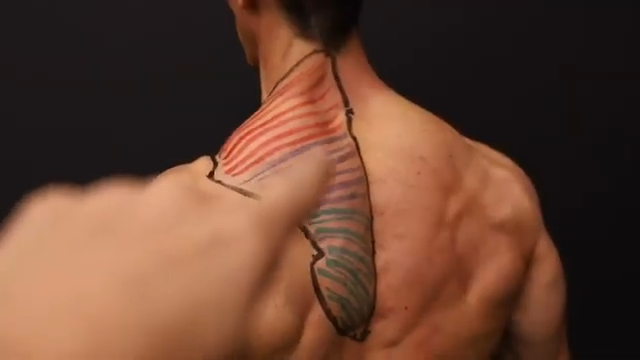
Let’s kick things off with the star of today’s show: the middle trapezius.
The middle fibers are located midway down your back, sandwiched between the upper traps (running along your neck and top of the shoulders) and the lower traps (closer to your lower back).
The main function of the mid traps is scapular retraction, which is the technical term for pulling back your shoulder blades.
It’s a movement that is essential to daily activities like opening a door or performing rowing exercises. It’s also an important action in maintaining correct posture.
Apart from retraction, the mid traps help with the elevation (shrugging) and depression (pulling down) of the shoulder blades.
With that said, these two movements are predominantly managed by the upper and lower traps, respectively.
While compound exercises like Barbell Deadlifts and Barbell Rows do engage the mid traps to some extent, you’ll find that the exercises I cover below will work better.
UPPER TRAPS


Given their size and location, the upper traps tend to get the most attention out of the three. The muscle starts at the back of your skull and extends towards your shoulder.
The upper traps have several important functions, including elevating the shoulder blades (scapular elevation). You can see this type of movement during a shrugging exercise like Barbell Shrugs.
Working with muscles like the serratus anterior, they help with lifting your arms overhead (scapular upward rotation).
They also support neck extension, rotation, and lateral flexion, allowing you to tilt and turn your head.
Finally, just like the mid traps, they help you to maintain proper posture by keeping the shoulders back and the neck upright.
LOWER TRAPS

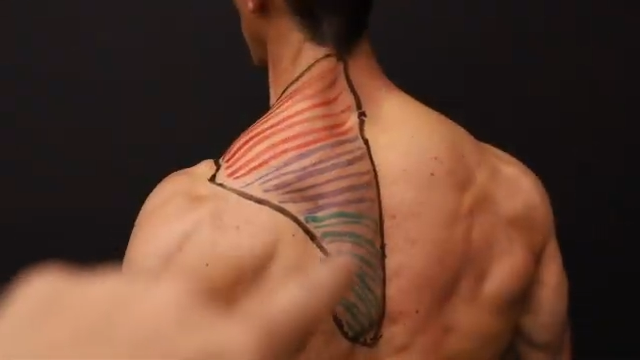
Last but not least, the lower trapezius muscles fibers orient downward, so that makes them great at pulling your shoulder blades down.
Better known as scapular depression, this muscle function is important for when you need to reach overhead.
The lower traps also assist in retracting and upwardly rotating the scapulae, especially during overhead arm movements.
For example, if you performed a Plate Press, your lower traps would kick in to retract and upwardly rotate your shoulder blades. At the same time, if you performed a Leaning Back Pulldown, your lower traps would also get involved.
EXERCISES FOR MIDDLE TRAPS
As I discussed, the mid traps have a hybrid function, which makes them unique.
Given their position, they want to kick in while we’re doing some of the upper trap work, and even some of the lower trap work.
What does this mean for you?
It means that you want to follow the fibers and their functions in order to properly activate the muscle and have a well-developed trapezius.
The way to do that is by keeping the movement arm short and not fully extending the arms into a ‘T.” This will help to remove the rear delts from the movement and put more focus on the mid traps.
In this case, the best way to target the mid traps is with a combination of high tension, high-low capabilities, and focused tension capabilities.
Here are the best middle trap exercises that play to the strengths of the muscle.
I’d recommend performing these exercises 1-2 times a week, assuming you’re doing a total of 3-4 workouts each week. Overall, this will depend on your shoulder workouts. Aim for at least once per week.
BACK WIDOW


HOW TO DO IT: Lay on your back on a comfortable surface. Now, focus on driving your elbows back and into the ground. Do not take your elbows out and drive with your hands. If you do, you’ll get more extension of the arms back behind your body and this would shift the focus more towards the rear delt, and even the triceps as you extend the elbows. You don’t want that. To really get to those middle traps, which are a harder to hit area, you want to make sure that we drive with the elbows. Squeeze the mid traps and slowly release, aiming to keep constant tension on the muscle. A 12-20+ rep range will work well here.
WHAT MAKES IT EFFECTIVE: By driving back and down with your elbows – not your arms or hands – you remove the rear delt from the exercise and focus the muscle contraction on the mid traps.
BACK WIDOW HOLD

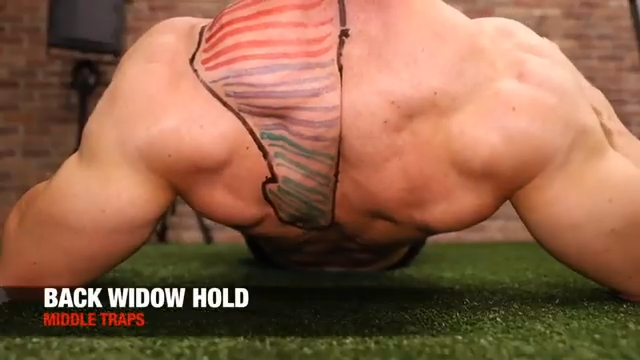
HOW TO DO IT: This is one of my favorite bodyweight exercises. Follow the same directions as above, but instead of performing rep after rep, I want you to do a long duration hold. Simply get in the same Back Widow position and hold the contraction for as long as you can. Aim for 45-60 seconds time under tension.
WHAT MAKES IT EFFECTIVE: While the Back Widow taps into the high tension, high-low strength of the muscle, the long duration hold plays to the focused tension ability of the mid traps.
WRAP AROUND ROW

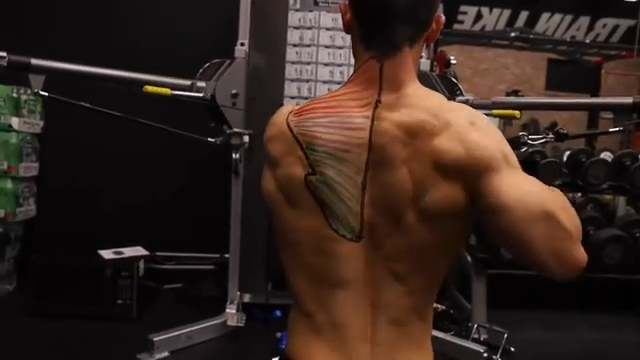
HOW TO DO IT: Stand or kneel at a cable machine. Set the cable machine pulleys to have a wide grip. This will help you get a good pre-stretch on the middle traps. Grab the left cable pulley with the right hand and vice versa. Keep the spine straight. Leading with the elbows, pull your arms back, squeezing the shoulder blades together. Pause for a moment then slowly return to the starting position, feeling that stretch across the mid traps. Remember, these are not Lateral Raises – you shouldn’t feel this in your middle or rear delts. Aim for the 10-20 rep range here.
WHAT MAKES IT EFFECTIVE: By positioning the cable machine pulls wide, you are able to set the stage for a better recruitment of these harder to reach muscle fibers.
HOW TO DO IT: Follow the same directions as above but pause and hold at the top of the movement. Focus the contraction on your mid traps, squeeze, and hold for as long as you can. Slowly return to the starting position once you start to lose proper form.
WHAT MAKES IT EFFECTIVE: Again, your mid traps love focused tension exercises. This long duration hold is perfect for tapping into that capability, making it one of the most effective exercises for the mid traps.
FACE PULL WITH ELEVATED RAISE

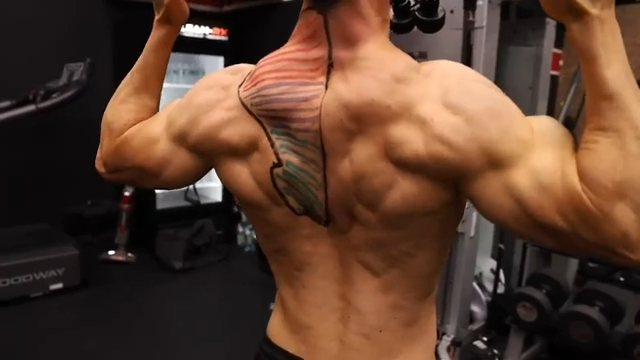
HOW TO DO IT: This will be just like one of my favorite cable exercises – the standard Face Pull – but you’ll add an overhead extension at the end. Holding on to the cable machine rope, lead with your hands as you pull it toward your face. Again, focus on leading with the hands, not the elbows, as this helps to avoid internal rotation of the shoulder. Your goal is to create external rotation and get the shoulder working with the rotator cuff and the mid-scapular muscles. Once the rope is next to your ears, push up above your head. Hold at the top then slowly reverse the movement. Shoot for the 6-12 rep range at around the 60-70% intensity range.
WHAT MAKES IT EFFECTIVE: What’s great about mid trap exercises like this is that the force is pulling you forward, requiring the middle traps to work harder to ensure the shoulder blades stay retracted. Keep in mind that you’ll feel this in the lower traps as well as you push overhead.
DUMBBELL PRONE PRESS

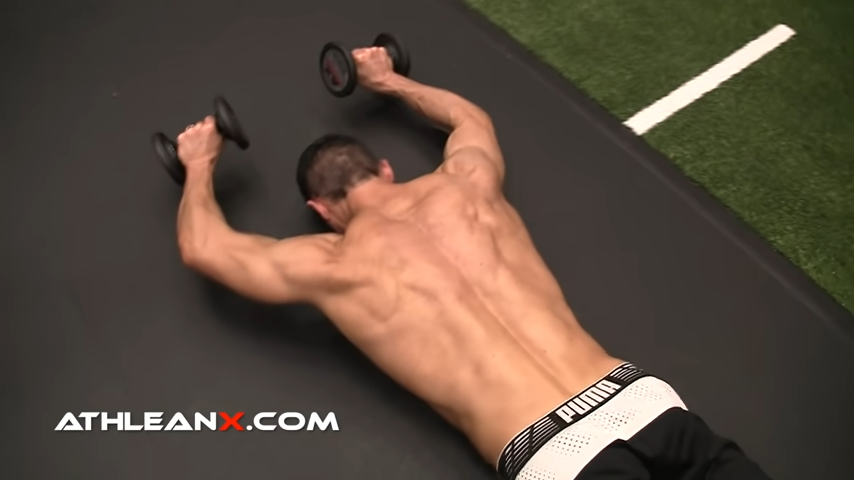
HOW TO DO IT: This is a very controlled exercise. Lie on the ground with a pair of dumbbells in your hands. Make sure you have an overhand grip and you’re using light weights. Make a “W” with your arms at the starting position. With your head down and in a neutral position, push the dumbbells forward. Do not let them touch the ground. Focus the contraction in your middle and lower trap muscles. Pause at the top of the exercise and slowly return to the starting position. You can also try this on a bench but be sure to use lighter weights and concentrate on a complete range of motion. Aim for the 3-10 rep range.
WHAT MAKES IT EFFECTIVE: By lying down, you remove the possibility of using momentum when moving the weight.
OVERHEAD CABLE TRAP RAISE


HOW TO DO IT: Stand in front of a cable machine. Set the pulley rope at a position that allows you to begin with your arms at a parallel angle to the ground or shoulder level. Although it’s tempting to use an underhand grip here, go with a neutral grip. Keeping the arms straight, pull up and over your head. Focus the contraction in the middle and lower traps. Pause and slowly let the cable rope down until your arms are at a parallel level with the floor again. Take your time and move with intention throughout the entire movement. This is a tough exercise so be sure to use light weights when you’re just starting out. If you only get within a 3-10 rep range, that’s okay!
WHAT MAKES IT EFFECTIVE: By setting the pulleys higher, this cable trap workout exercise removes the involvement of the front delts and focuses the movement on the mid traps.
Guys, I hope after reading this, you’ll give the mid traps the attention and love they deserve this week by adding 2-4 trap specific exercises to your workout routine.
Remember, it’s all about controlling the movement and in this case, the movement is squeezing those shoulder blades together.
Don’t rush through these exercises. Start with light dumbbells, light weights, focus on the contraction, and long duration hold.
Are you looking for a custom plan for your traps on shoulder days? We’ve got you covered. Check out our ATHLEAN-X programs to see which one is the best match for your goals and fitness levels.

- Of the three areas of the trapezius muscle fibers, the mid traps tend to get the least attention. This can be problematic since they are essential for proper posture and scapular retraction.
- To target this specific section of the traps, you’ll want to focus on exercises that require you to squeeze your shoulder blades together.
- You also want to use two types of exercises: high tension, high-low exercises and focused tension exercises.
- Before you begin, be sure to keep your ego in check. You’ll probably want to start out with lighter weights, focusing more on intense contractions and long-duration holds.
- For high tension, high-low exercises, I’d recommend the Back Widow, Wrap Around Row, Face Pull with Elevated Raise, Dumbbell Prone Press, and Overhead Cable Trap Raise.
- All these exercises can be turned into focused tension exercises by simply performing them with a long duration hold instead of multiple repetitions.
- Again, concentrate on a strong mind-to-muscle connection, not heavy weights. You want correct form throughout. Once your form goes, the set is over.
MIDDLE TRAP EXERCISES FAQS
It’s important to first look at the type of exercise that will work the mid traps. There are two types of exercises that the mid traps respond best to: high tension, high-low exercises and focused tension exercises.
With that said, I’d recommend incorporating a mix of both. You can even perform them in a superset fashion to fully exhaust the muscle.
Try the following exercises in your next workout routine: Back Widows, Wrap Around Rows, and Face Pulls with Elevated Raises.
To target the mid traps, focus on exercises that involve squeezing your shoulder blades together. In other words, perform scapular retraction exercises such as Back Widows, Seated Rows, and Face Pulls.
Isolating the middle trapezius can be challenging since multiple muscles are often engaged in back exercises.
However, by keeping the elbows tight to the body as you bring your shoulder blades together, you can remove the involvement of nearby muscles like the rear delts.
I recommend exercises like the Face Pull with Elevated Raise, Dumbbell Prone Press, and Overhead Cable Trap Raise to specifically target the mid traps.
Shrugs are primarily an upper trap exercise; however, they can also engage the middle trapezius to some extent, especially if you focus on squeezing your shoulder blades together as you lift.
However, they aren't the best exercise for specifically targeting the middle trapezius.
For that, you're better off with scapular retraction exercises like Back Widows, Face Pull with Elevated Raise, and Wrap Around Rows.
Strengthening the rhomboids and mid traps involves exercises that promote scapular retraction or squeezing the shoulder blades together.
These exercises include Face Pull with Elevated Raise, Back Widows, and Wrap Around Rows.
To specifically engage the rhomboids and mid traps, focus on the squeezing motion, hold it for a couple of seconds, then slowly return to the starting position. Ensure you're using lighter weights that allow for controlled movement and don’t compromise your form.

Jeff Cavaliere M.S.P.T, CSCS
Jeff Cavaliere is a Physical Therapist, Strength Coach and creator of the ATHLEAN-X Training Programs and ATHLEAN-Rx Supplements. He has a Masters in Physical Therapy (MSPT) and has worked as Head Physical Therapist for the New York Mets, as well as training many elite professional athletes in Major League Baseball, NFL, MMA and professional wrestling. His programs produce “next level” achievements in muscle size, strength and performance for professional athletes and anyone looking to build a muscular athletic physique.
















